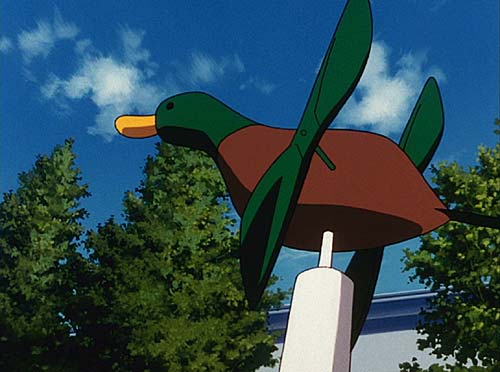
Duck
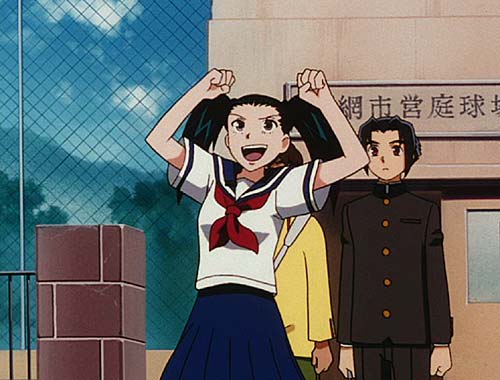
Old-fashioned seifuku
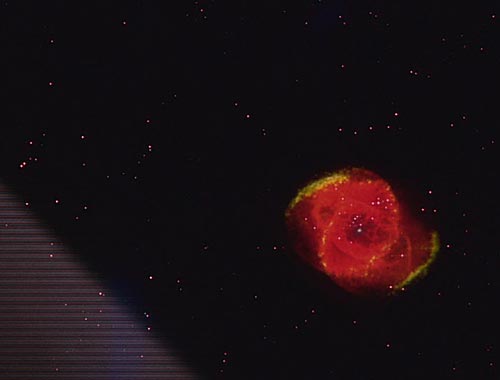
Trivia that matter
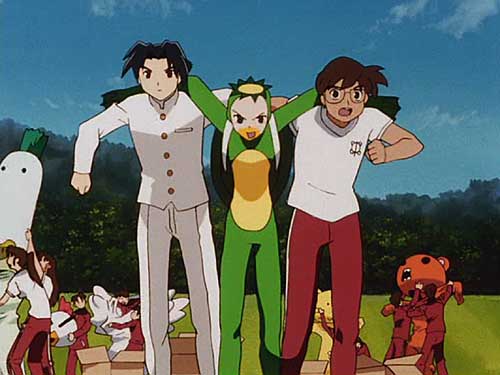
Shingu is the perfect show to recover with after Divergence Eve/Misaki Chronicles. The fate of the Earth, perhaps the entire galaxy, may hang in the balance, but six episodes in, the outstanding characteristic of the show is its playfulness.

Misaki Chronicles and Shingu just arrived. Don’t expect much posting here for a few days.
Update: Just finished Misaki Chronicles. A few quick notes:
1. Wow.
2. I want to let the story settle in my mind a day or two before I watch anything else. Shingu will have to wait.
3. Somebody please shoot the character designer and the jiggle choreographer.
4. Misaki and her colleagues are cute — from the neck up, anyway — but Lyar von Ertiana is the one I want to meet.
5. Much of the anime that I find memorable deals with grief and despair. Few series do so as directly as Misaki Chronicles.
6. Wow, again.
I’ve watched each of the first five episodes of Denno Coil at least twice so far. I have a few small reservations, but overall I’m very impressed. Iso and company have yet to stumble. If these five episodes are indicative, this is the best show I’ve seen on fansub yet and one of the best of any kind ever. I was initially concerned that there wouldn’t be enough material to stretch twenty-six episodes; now my concern that twenty-six will barely be enough to elucidate all the mysteries of Daikoku City and the connections between Yasako and Isako. Denno Coil is a pleasure to watch on every level. I don’t often write about quality of animation because I don’t have the background, but even I can tell that the work here is exceptional. Watching the different ways the various characters in the opening climb stairs is an education in the art of animation. Daikoku City may be a virtual world, but it’s one of the most believable I’ve ever visited.
Eleven episodes of Seirei no Moribito have been translated now. The last few have been surprisingly quiet (not that I mind; there are few things duller than non-stop action). It looks like the story might be as much about the education of the prince as about eluding assassins.
I’m watching Sugar, a Tiny Snow Fairy slowly, one episode a day. I watched the ninth today, which is the beginning of the “Bear Pianist” arc, my favorite part of the series. Overall, it’s as good as I remember it, but not all parts have aged equally well. The Elder’s infatuation with Ginger gets old fast, and after the fluid animation of Denno Coil, Sugar looks just a little wooden. The writing and acting generally are very good, though, and the music is better than I remembered. One recurring theme reminds me strongly of Metamora, and I keep expecting to hear Malcolm Dalglish’s dulcimer.
Addendum: Here’s some Denno Coil motivation.
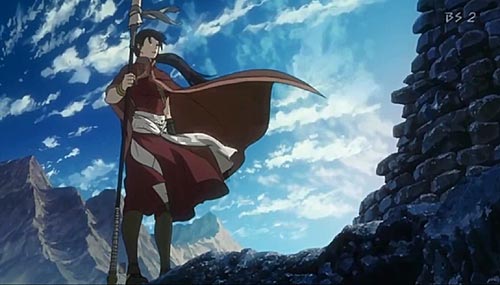
I’m down to three fansubs: two substantial stories, Denno Coil and Seirei no Moribito, and a cheesy entertainment, Murder Princess. ((I might add Oh! Edo Rocket to the list, depending on how good the second episode is. I hope to see more of the Waragetcha 5, but the translation of Master of Epic proceeds very slowly. I may resume watching Darker Than Black, Claymore and El Cazador, depending on what I read about further episodes.)) At this point, I think that DC and SnM are the two best shows of the year and better than anything from last year. ((I count Mushishi as a 2005 series.)) (I reserve the right to change my mind if either turns stupid, but I doubt that will happen.) I hesitate to write any more about the former lest I oversell it, ((Here’s the Denno Coil opening and trailer combined, which hints at the quality of the production and the tone.)) but latter deserves some comment.
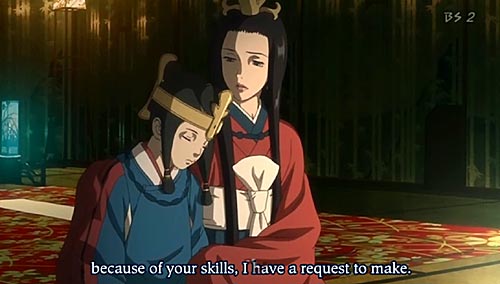
Seirei no Moribito, or Guardian of the Sacred Spirit, is set in a mythical Asian land. Balsa, an expert spearwoman, rescues the prince Chagum from drowning when the oxcart he is traveling in falls off a bridge. His mother subsequently asks Balsa to be his bodyguard. Chagum needs one; he contains within himself the egg of a water spirit, and for reasons connected with that, his father the emperor wants him dead. Thus far, Balsa and Chagum have evaded the assassins, and eleven-year-old Chagum is learning about life outside the palace.
Production values are high, but the appeal of Seirei no Moribito is in the characters and story. Balsa and Chagum are fully-realized three-dimensional, sympathetic characters. Chagum in particular is appealing, combining a deep sense of responsibiility with childish naiveté. It is easy to imagine him growing up to be emperor someday.
Seirei no Moribito is based on a series of novels by Nahoko Uehashi. The makers of the anime have enough confidence in the story that they don’t feel any need to make every episode action-packed. When there is fighting, it’s spectacular (here are excerpts from the third episode ((This is mildly spoilerish, but you don’t really expect the central characters to be killed off that early, do you?)) ), but it’s sparse. The eighth episode is particularly suspenseful, and it’s mostly just characters talking and telling stories.
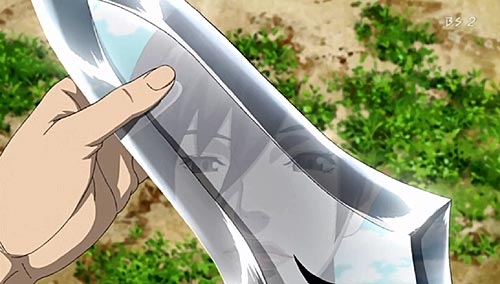
One element worth noting is that, although Balsa and Chagum don’t lack enemies, none of the characters thus far are evil, not even the emperor who orders his son’s death. The imperial diviners have discovered ominous signs that may be connected with the water spirit, or demon, within the prince, and the emperor’s decision, tragically wrong though it may be, is understandable. (My hunch is that there is indeed a connection, but it’s not what they think, and Chagum’s death would be disastrous.)
I’m violating my usual policy in watching Seirei no Moribito. Hitherto, I have never downloaded a fansub of a show once a license was announced (it’s going to be a long time before I know how Death Note ends). My feeble excuse is that this is one of the best series I’ve seen in a long time, I’m impatient to see the rest, and there is as yet no mention of it under either title on the Geneon website. If you have the self-control, the ideal course of action is to emulate Wabi Sabi: wait until the entire series is available, and then marathon the show. Here in region 1, that could quite possibly involve a two-year wait.
Posting will resume when I’m less frazzled by construction, bad weather and bad smells — remodeling and plumbing problems at work, roof destruction and replacement during unstable weather at home. Until then, here’s Yukari and Matsuri from Rocket Girls.
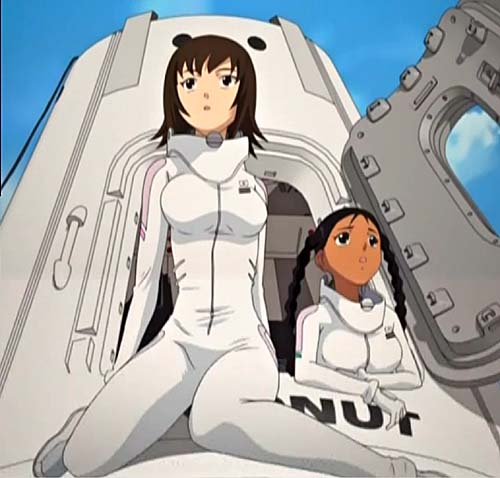
*****
Today’s word: “Waffo!” (Yes, the Right Stuf order arrived in less than a week.)
Don’t watch the beginning of Divergence Eve in the afternoon unless you have the evening free.
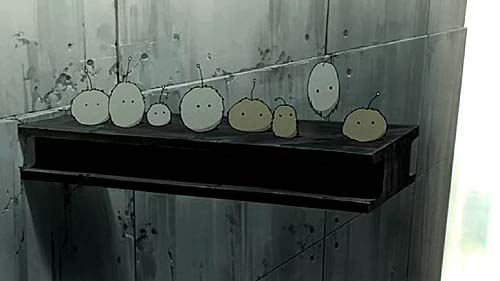
The second episode of Denno Coil introduces the adult members of Yuko/Yasako’s ((Yuko asks her friends to call her “Yasako.”)) family and adds another layer of complexity to the story. We meet her parents, but it’s Mega-baa, her grandmother, who dominates the episode. The crafty old woman runs the combination sweets store and cybershop where Fumie buys her kuro bug spray and other toys. Mega-baa can cure Yasako’s cyberpet of its virus, but there’s a price.
The connections between the real and virtual worlds become increasingly complicated. “Satchii,” a powerful but stupid antivirus program, cannot enter homes, schools or Shinto shrines. By slapping the appropriate “metatag” on the traffic light post, Fumie can change them to red — useful when Satchii is chasing the girls. By slapping a different metatag on Yasako’s forehead, Fumie enables her to fire beams from her glasses. (The beams looks like bolts of energy, but they seem seem to act by disrupting data, causing flickering gaps where they strike.)
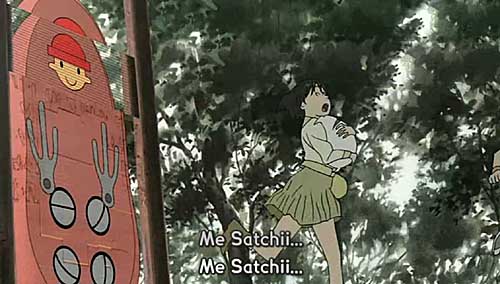
There is evidence that the humans in Daikoku City are themselves at least partly cybernetic. There’s also the puzzle that, although Yasako can pick up and hold Densuke, implying that there is some tactile feedback, she can’t tell if he is as soft and fluffy as he looks.
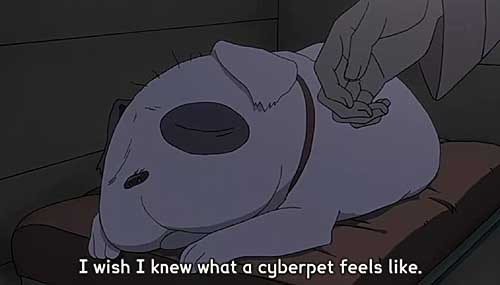
Besides the cybernetic paradoxes, Yasako also discovers that she may have forgotten important details of an earlier visit to Daikoku City when she was quite young. As she investigates the mysteries of the city, Yasako will likely discover much about herself and her family.
It’s too early to be sure, but I think that Denno Coil is probably the outstanding show of the spring. ((The other contenders are Seirei no Moribito, about which I’ll try to write something coherent soon, and Darker Than Black, the first two episodes of which are excellent, though it’s not what I enjoy. Astro discusses the latter here.)) These two episodes are as re-watchable as the first three of Kamichu! Everything is done well. The colors are muted, suggesting water colors, and the character designs are simple but expressive. There’s no cloying KyoAni prettiness here; instead, this highly artificial world seems natural and believeable. Yasako is an attractive character, and Mega-baa is quite formidable and interesting.
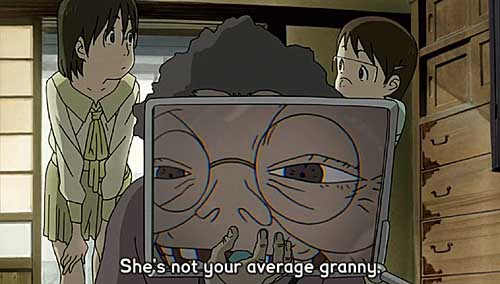
Thus far, Mitsuo Iso and company have been introducing the characters and setting up the rules of their world. What the story will ultimately be is not clear yet. Iso’s theme, according to one writer, is “the distance that separates everyone.” It’s not much in evidence yet, but there are twenty-four episodes to go. If Denno Coil ends as well as it begins, it might be a classic. (Of course, it could degenerate into an illogical mess, but given how sure-footed these two episodes are, I think we can reasonably hope for the best.)
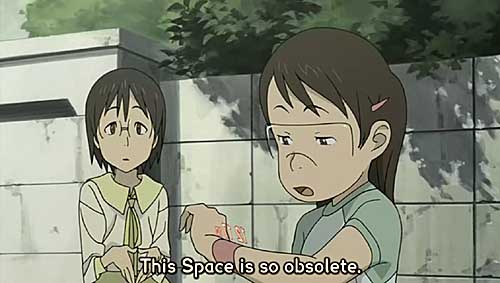
Yuko, newly arrived in Daikoku City with her impulsive little sister Kyoko, loses her dog Densuke when it chases an “illegal” — a sort of computer virus — through a hole in a fence into an “obsolete” cyberspace. Fumie’s business is retrieving lost cyberpets, and Yuko hires her to rescue Densuke. It’s a more difficult job than they anticipate.
Episode one of Denno Coil is the first episode of any of this season’s series that I watched a second time, which automatically makes it the coolest show currently being broadcast. In some respects, it really does seem like Serial Experiments Lain retold for youngsters. Virtual spaces are coincident with the everyday world, and one can open holes to the cyberspaces with “bug” spray. Children have cyberpets that look and behave like real dogs and cats but are visible only to those who wear special glasses. It is possible to pick up and hold these pets, and they can freely pass through the holes into cyberspaces. They don’t like it when you drop a backpack on/through them. Numerous small floating spheres constantly monitor Daikoku City for cybernetic breaches, blasting suspicious areas with a sort of ray.
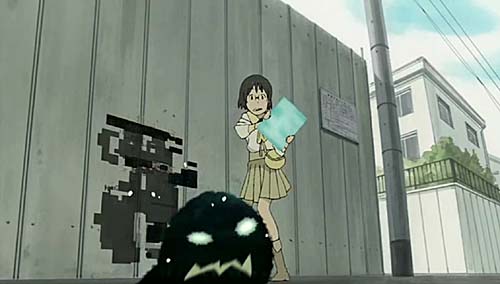
The first episode is very promising. The characters have distinct, non-cliche personalities, and the Denno Coil universe is the most interesting I’ve come across recently. Whether Denno Coil remains cool depends in part in how carefully and consistently director and writer Mitsuo Iso works out the logic of the intersecting real and virtual worlds. It also depends on whether he has twenty-six episodes’ worth of story to tell. The character designs are simplified but serviceable (though the characters who wear visors instead of glasses look like they have pig noses), and the art and the animation are adequate. The background music sounds interesting when I’m aware of it.
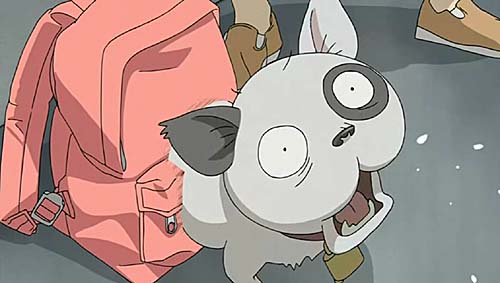
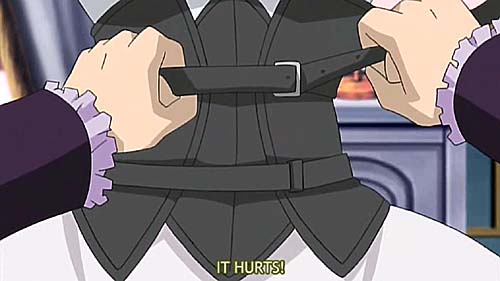
According to historical costumers, a properly-fitted corset is quite comfortable. Evidentally, in Foreland the craft of corsetry has sadly declined.
After the over-the-top first episode, the second episode of Murder Princess is a bit of a let-down as the former bounty hunter ((What is it with bounty hunters, anyway? I would have thought that Cowboy Bebop adequately covered the subject, but they keep turning up everywhere. Half the characters in El Cazador are bounty hunters.)) discovers the challenges of palace life. It’s still quite watchable, though, and it’s hard to dislike a series in which the good guys look like this:
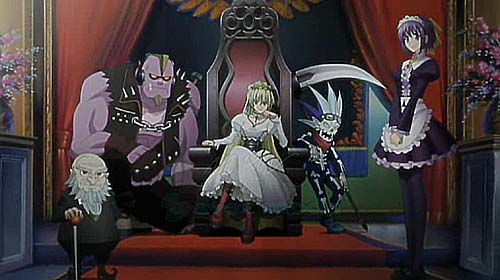
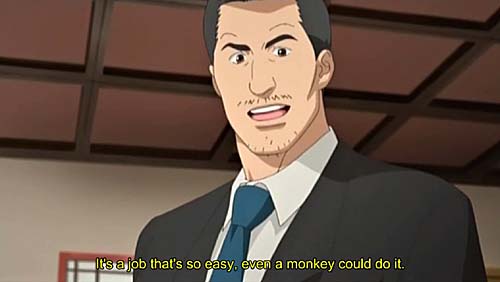
I could complain about the manifold implausibilites of Rocket Girls, but it would be pointless. How can you expect logic in a universe where a space agency drafts random high school girls to be astronauts merely because they’re lightweight? Instead, it’s better to focus on the incidental pleasures, such as classic calculators
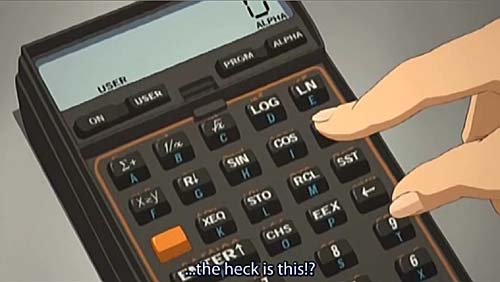
or cigarette lighters
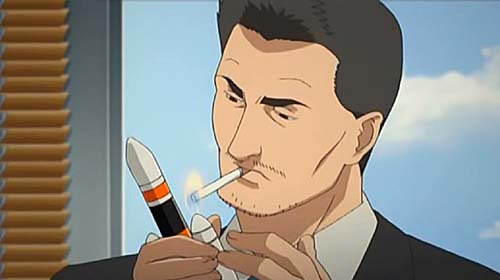
or girls wearing skin-tight space suits. (Never mind that the suits are basically three millimeters of silicone rubber, and the story is set in the tropics. Heatstroke doesn’t happen in anime.)

The story zips right along, and there’s no time for teen angst. Yukari, spending her vacation in the Solomon Islands looking for her father who disappeared seventeen years ago, is variously bewildered, shocked, appalled, outraged, exasperated, disgusted and just plain angry as she learns just what her “part-time job” entails and discovers a few things about her family. If Yukari really had sense, she would run away from all these crazy people as fast as she could, but then there would be no anime. She’s soon joined by Matsuri, a native islander, and one of Yukari’s classmates from Japan should arrive on the island shortly.
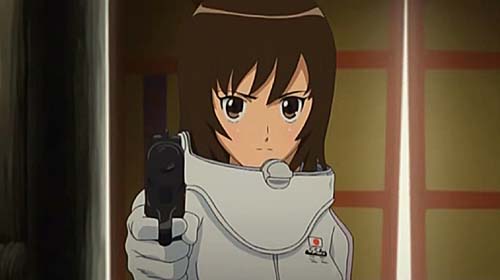
Despite all the nonsense and the bad computer animation, Rocket Girls is enjoyable. It’s partly because it doesn’t take itself terribly seriously, and partly because, although the show gets the details wrong, it gets the story right. The people who made Rocket Girls, I think, really do want to go into space.
I need to watch it again to make sure that there aren’t any paradoxes left dangling and that the writers didn’t cheat at the end, but one thing is clear: it is every bit as good as it is said to be. I doubt that I’ll see a better movie this year. The story is interesting and the central characters are three-dimensional. The production may not be as glossy as a Studio Ghibli epic, but it’s more than adequate, and the script and the acting are first-rate. I will be astonished (and appalled) if TokiKake isn’t quickly licensed, and I hope that whoever does bring it over makes an effort to market it to all audiences, not just anime fans.
Wabi Sabi comments on some of the motifs here (spoilers).
Here’s a curiosity I noticed. I wonder if it was intentional.

Now would someone please translate the book.
*****
It turns out that TokiKake is not an adaptation of the novel by Yasutaka Tsutsui but is a “continuation” of it, set twenty years later. The protagonist of the novel appears in the movie as “Aunt Witch.”
Here’s Yasutaka Tsutsui’s site. It includes a profile that I hope is misleadingly pretentious and English translations of some of his short stories.
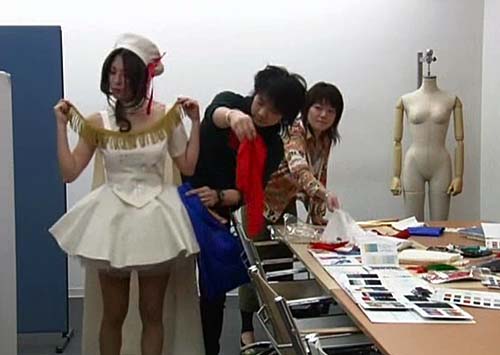
Bishoujo Celeb Panchanne is a live-action mahou shoujo spoof in which a former magical girl, now a happily married mother, is persuaded by a rather seedy kami-sama to wear the short skirt again. I’ve only seen the raw for the first episode, so I don’t know what the silly/stupid ratio is, but it looks quite cheesy, as Pixy observed. It’s also very low budget: the alien space ship looks curiously like the device I use to steam peas and corn. It does feature one element of realism missing from every other mahou shoujo show I’ve seen: we get to see Panchanne’s costume designed and constructed. ((Cardcaptor Sakura is a special case, and I don’t think we ever actually see Tomoyo sewing.)) (She still undergoes the usual magical transformation when it’s time to face the monster of the week.)
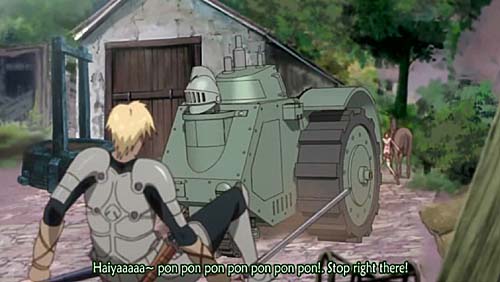
Ludicrous though it is as Shakespeare, if you ignore the characters’ names, Romeo x Juliet becomes a generic fantasy action show, a bit slicker than most but otherwise of no particular distinction. If it’s something truly ridiculous you want, I recommend Sisters of Wellber. In the first episode we have swords, guns, sword-guns, plate armor, a fairy, cigarettes, facial markings, a guy named Galahad, artificial intelligence and a tank that talks too much. There’s also mention of a “Killer Bee Man.” This isn’t schizotech; this is just plain silly. I suppose it’s part of the writers’ strategy: if anything can happen, you don’t have to worry about consistency. What’s frustrating is that there might be a decent story about interesting characters here — the principals are a princess who may or may not have killed a prince from a different kingdom, and the thief who becomes her protector — but it’s lost under all the senseless gimmicks.
Very quick first impression: I just watched the first episode of Toward the Terra. It’s potentially first-rate, but I’m reminded strongly of RahXephon. This is not necessarily bad. The first half of RahXephon had some serious flaws ((The most annoying was the profound incuriosity of the protagonist, who never asked the obvious questions.)) but was quite watchable, even with the damned mecha. It did eventually collapse into pretentious twaddle, though. I hope the people behind Toward the Terra have thought their story through.
Wabi Sabi has begun a weblog devoted to Toward the Terra that might be a useful resource.
The closing song is just enough like Pachelbel’s “Canon” to be seriously irritating.
Some comments on what I’ve recently watched.
Claymore — The first episode features the grossest scene I’ve endured since the first Alien movie. There isn’t anything as grotesque in the second episode, but it’s no milder. Houko Kuwashima departs from her characteristic role as an emotionless girl by playing an emotionless woman (well, half-woman). ((Kuwashima is a versatile actress, but about half her roles are silent, withdrawn characters, notably Kirika Yuumura. She does them well, but I like her better when she plays vivacious women such as Shuurei in Saiunkoku Monogatari.)) Despite my distate for gore and horror, I’m curious to see what kind of story emerges in the series. I’ll continue watching as long as it doesn’t try too hard to gross me out.
El Cazador de la Bruja — Thus far, the most interesting show of the spring, and I definitely will be following it. The challenge for me will be to not constantly compare it to Noir. There are many similarities — it’s the third of Koichi Mashimo’s informal girls-with-guns trilogy — but Ryoe Tsukimura is not involved this time and I don’t expect the overwhelming intensity of the earlier series. What I do expect is a complicated plot involving conspiracies within conspiracies, and a lighter, occasionally humorous tone in this tale of Maxwell’s Demon in Latin America. I hope Mashimo can pull it off without too egregiously violating the laws of physics and probability.
Hayate no Gotoku, or Hayate, the Combat Butler — The English title is the best part of the show. The series itself is lightweight, formulaic comedy, entertaining and nothing more. It’s not good enough to pay money for should it be licensed, so I’ll probably skip the rest of it.
Kami-chama Karin — I think of Koge Donbo as the cheerful Japanese counterpart of Margaret Keane. Her art is off the scale on the kawaii meter. Unfortunately, she’s not as good a storyteller as she is an artist. Kami-chama Karin is her idea of a mahou shoujo story. The principals are cute, but I get very irritated with them. Novice goddess Karin doesn’t ask the questions she should, and Kazune, who should be her coach and mentor, is more likely to lose his temper than explain what she needs to know. If you need a kawaii fix, watch Sugar again instead.
Murder Princess is potentially good, lurid fun, and I’m impatiently waiting for the second episode. Monster Princess, on the other hand, is just trashy.
William Shakespeare:
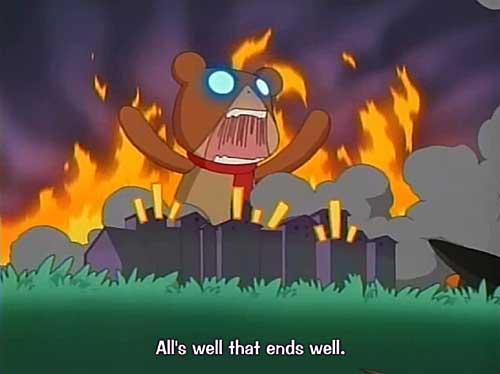
Naoko Takeuchi:
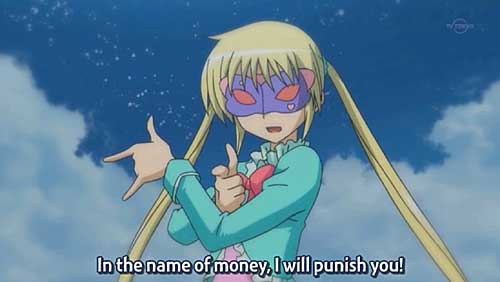
Addendum: Here’s the clip.
Kansas, according to L. Frank Baum:
When Dorothy stood in the doorway and looked around, she could see nothing but the great gray prairie on every side. Not a tree nor a house broke the broad sweep of flat country that reached to the edge of the sky in all directions. The sun had baked the plowed land into a gray mass, with little cracks running through it. Even the grass was not green, for the sun had burned the tops of the long blades until they were the same gray color to be seen everywhere. Once the house had been painted, but the sun blistered the paint and the rains washed it away, and now the house was as dull and gray as everything else.
When Aunt Em came there to live she was a young, pretty wife. The sun and wind had changed her, too. They had taken the sparkle from her eyes and left them a sober gray; they had taken the red from her cheeks and lips, and they were gray also. She was thin and gaunt, and never smiled now. When Dorothy, who was an orphan, first came to her, Aunt Em had been so startled by the child’s laughter that she would scream and press her hand upon her heart whenever Dorothy’s merry voice reached her ears; and she still looked at the little girl with wonder that she could find anything to laugh at.
Uncle Henry never laughed. He worked hard from morning till night and did not know what joy was. He was gray also, from his long beard to his rough boots, and he looked stern and solemn, and rarely spoke.
Kansas, according to Oz no Mahou Tsukai:
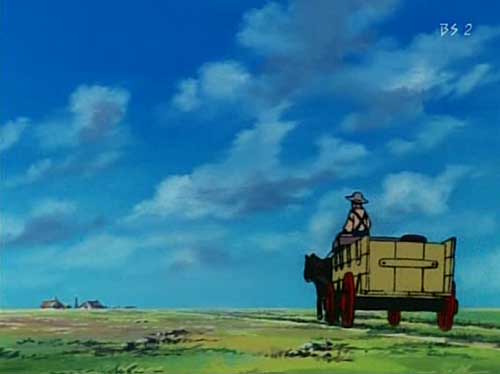
I’ve lived in Kansas for the larger portion of my life, and I’ve never seen Baum’s grey Kansas. During tornado season (March through June), it’s mostly green. Although joyless grey people do exist in the plains states, they can be found anywhere. They’re not specifically prairie phenomena.
Here is a more representative Kansas farm couple:
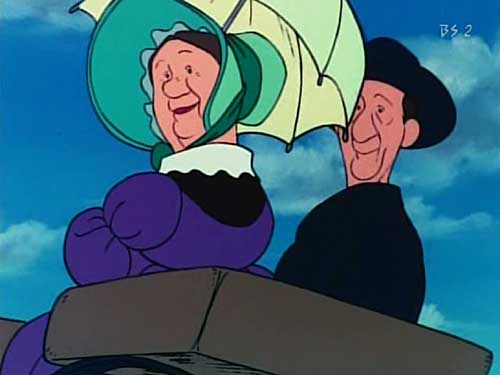
Only the first episode of Oz no Mahou Tsukai (1986) has been subtitled. It’s watchable but not outstanding. If a group decides to fansub the remaining 51 episodes, I’ll probably download them for my nephews and nieces, but if they remain untranslated, it will be no great loss.
Between banging out old tunes on the dulcimer and fixing my bike, I did find time to watch a few odds and ends this week.
Because of Pete’s advocacy, I watched the first two episodes of Manabi Straight again. Maybe I will view the rest, after all. The girls still look way too young, but you become inured to that, and while they act younger than high school students should, so do most high school students. I don’t know that I will like the show as much as Pete does, but I can say that it is more genuinely funny than Lucky Star.
I came across a subtitled “screener” of Paprika. I hope it gets a proper theatrical release in America, because this is one movie you definitely want to see on the big screen if at all possible. It’s a spectacular trip. How good it is, I haven’t decided. My snap judgment is that it’s very good, but the whole is less than the sum of its parts. Some of those parts are amazing, though, and Paprika is never less than entertaining at any time.
Both Paprika and Toki wo Kakeru Shoujo are based on stories by Yasutaka Tsutsui. I’m curious about him, so my most recent Amazon.com order included Salmonella Men on Planet Porno. It will give me something to read while I’m waiting for the movies. (Nick will be pleased to learn that I also ordered The Twelve Kingdoms: Sea of Shadow.)